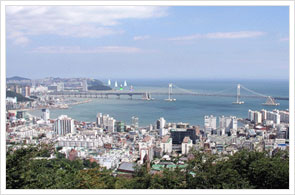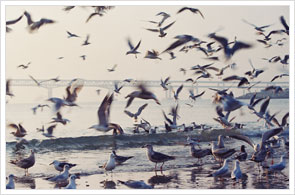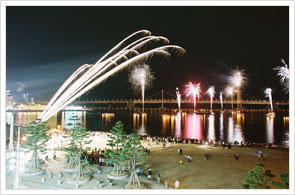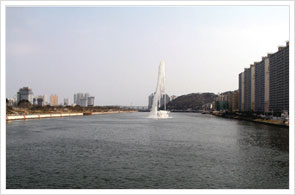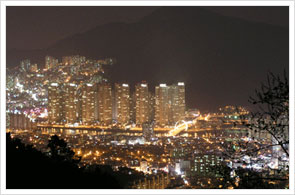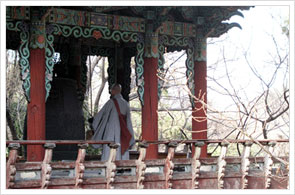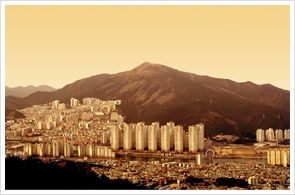Tourist attractions
- Eight beautiful sceneries of Suyeong
-
- 작성일 : 2019-11-05 16:27:58
- 조회수 : 110
Eight beautiful sceneries of Suyeong
The last vital force of the Taebaek Mountains was gathered to be entered to the downtown Busan and create the Mount Geumryeon Range that leads to Namcheon Bay along with Mount Hwangryeong and Mount Geumryeon.
As the southwest of Suyeong becomes Busan Bay in Busan Port, and the southeast of Suyeong becomes Suyeong Bay and Suyeong River, Suyeong that harmonizes the land, the sea and the river can be said to be a scenic spot on the whole.
In the past, people boasted of the eight beautiful sceneries of Suyeong in this scenic spot, and the eight beautiful sceneries refer to a wonderful sight viewed from the present Suyeong Fortress in Suyeong-dong and are said to have been told to Ji-hong Park, a Korean linguist, through Han-bok Choi, a local historian, before being widely known.
Undaeguibeom
Undae in Undaeguibeom stems from Haeundae, and a village located in western Dongbaek Island in the middle of Joseon Dynasty was called Undae-ri. It refers to sentimental warmth related to sailing ships returning to Suyeong from Haeundae, and the sails of the sailing ships fully reflect an evening glow to create golden waves under the setting sun in the sea that becomes a waterway. A grand sight created by seagulls spreading golden-colored wings around sailing ships under the setting sun must have generated another unique sentiment.
Bongdaeweolchul
Bongdaeweolchul refers to landscape created by the moon rising over Bongsudae (Beacon Fire Station). In old times, Bongsudae in Mount Ganbio originated from Mount Jangsan in Haeundae was called Bongdae (Signal Beacon Post), but the moon-rising location viewed from the present Suyeong (Jwasuyeong Fortress) was over the Bongdae in Mount Ganbio. When the moon rose from the east over the Bongdae, the shadow of the surrounding mountain under the moonlight generated a grand sight reminiscent of a black-and-white painting, and golden-colored waves lapped in the coastal waters of Suyeong. In addition, a single signal fire in a beacon post (signifying peacetime) notified peace, and when the bright moon over the beacon post shined all over the place, it meant peaceful times.
Jindu Eohwa
Jindu refers to a river port where ships come and go, and Eohwa refers to a lamp or torchlight lit on a fishing boat. Overall, it refers to a grand sight created by lights originated from fishing boats far from a ferry. Jindu is assumed to have been a port located around the present Suyeong Bridge No. 2 in Millak-dong (as indicated in a map of Jwasuyeong). A magnificent scenery is assumed to have been made with lights from boating ships coming and going around Suyeong Fortress.
Namjang Nakan
Namjang refers to a sandy beach in front of Namchon and is a vast sand dune and currently known as Gwangan (meaning a vast hill in Chinese). The meaning of ‘an’ in Gwang-an originally meant a hill in Chinese and later changed into ‘comfort.’ It is said that a large flock of wild geese created a fantastic sight in Gwangalli Beach. These geese come here in the fall to find something to eat and stay in the winter spending time free-flying before returning in the spring. The geese descending onto the vast sandy beach of Namjang (Gwangan) must have presented a spectacular sight. A beach was established in the Gwangalli Beach when students were taught to swim and exercise the body and the mind here during their summer vacation when the Japanese colonized Korea.
Baeksan Manchui
Mount Baeksan is located in Millak-dong, and a hill at the summit was called Baekjadae. As for the origin of Mount Baeksan (meaning a white mountain), as the mist of the coastal sea and Suyeong River wrapped around the mountain or white clouds covered the mountain from time to time, it often looked white so it was named so. It was also called Mount Baekhaksan (meaning a white crane), as white cranes flocked here. This mountain is called Neolguji as its southern part jutting out into the sea became a plank-shaped elongated cape (a smaller peninsula-like area where the land is jutted out into the sea). Gyeongsangjwasu Yeongyeongjidohyeong of Gyeongsan-do Map indicated this Neolguji as Palgonri. As the area into which Mount Baeksan is jutted out is surrounded by the sea, the blue color of Mount Baeksan, its curves, white cranes sitting on old pine trees and the shadow of rocks are said to have created a spectacular scenery at sunset.
Jaesong Jikhwa
Jaesong Jikhwa refers to glow around looms weaving hemp cloth in Jaesong, and it is said that the sound generated when the womenfolks in Jaesong-ri wove hemp cloth never stopped day and night. When the womenfolks wove hemp cloth at night, they are said to have lit a lamp above a loom. As each and every house lit a lamp, if it had been viewed from Suyeong across Suyeong River, it would have looked like firefly light swaying among pine trees at summer night. Dongrae Hyeonjo of Donggukyeojiseungram records “Jaesongpo is 40km away from Dongrae-hyeon, and there are tens of thousands of pine trees.” Jaesongpo, the former site of the airfield (currently, a container freight station) of Suyeong, was made as a dune was formed to become land.
Yeonsan Mojong
Yeonsan in Yeonsangjong originated from Mount Geum’ryeon,’ and Mount Geumryeon is the main mountain of Suyeong, and Mojong refers to the sound of a Buddhist temple bell generated from the world of suffering. It is said that there were Mahasa Buddhist Temple, Banyaam Hermitage and Baramilda Buddhist Temple that are known to be old temples in the mountain. Today, there remains the Mahasa Buddhist Temple, and there are only the retaining walls of Banyaam Hermitage and Baramilda Buddhist Temple in the hill across the entry of Mahasa Buddhist Temple. A long time ago, the sound of a Buddhist temple bell reverberated from the Mahasa Buddhist Temple to the world of suffering at sunset must have calmed five carnal desires and seven emotions. If one happens to hear the delicate sound of a Buddhist temple bell in Suyeong, he would realize the true meaning of the state of nirvana and spiritual awakening. “Landscape does not have to be confined to what one can see. Rather, the sound reverberating far afield for all eternity can be another form of landscape.”- The eight beautiful sceneries of Suyeong well reflects the wisdom of our ancestors who regarded the sound of a Buddhist temple bell as another form of landscape.
Jangsan Nakjo
Jangsan Nakjo refers to the landscape that the setting sun reflects Mount Jangsan. If you turn your head toward northeast from Suyeong, you would be able to see a cone-shaped towering Mount Jangsan over Suyeong River. Donggukyeojiseungram called it Mount Sangsan, and Dongraebuji recorded it as Mount Sangsan or Mount Jangsan. In the past, people guessed time through the setting sun or the rising sun, and Mount Jangsan is considered as a place where the setting sun stands out the most. Mount Jangsan is cone-shaped, so sun shadow gradually and slowly moves up toward the summit of the mountain from the bottom. In other words, a dark shadow gradually and slowly goes up to reach brightness at the top is a scenery viewed from Suyeong.

